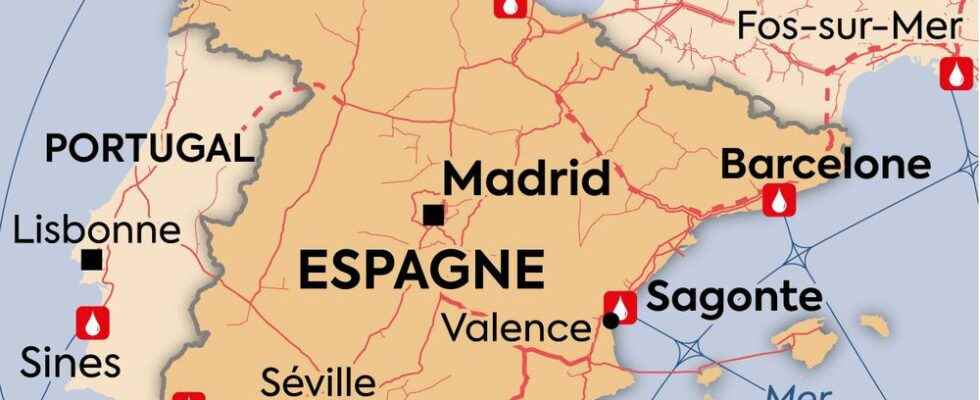“Preventive action to strengthen the gas system and anticipate problems linked to price volatility” in Europe. This is the argument put forward by the Spanish operator Enagas to explain the feverishness that currently reigns in the ports of the Iberian Peninsula. A feverishness due to the supply difficulties induced in Spain by the closure in November of the Maghreb Europe gas pipeline from Algeria, via Morocco. And for a few days, say government sources, by the threat of armed conflict in Ukraine. A company formerly owned by the State and listed on the Madrid Stock Exchange for twenty years, Enagas owns 11,000 kilometers of gas pipelines. It controls five of the six active regasification terminals in Spain. This is more than any other country in Europe, where terminals of this type are, in total, 32.
These plants, where LNG carriers transporting liquefied natural gas (LNG) by sea arrive, are located in Bilbao (in the Bay of Biscay), Huelva (at the entrance to the Strait of Gibraltar), Cartagena (opposite Algeria ), Sagunto (near Valencia)… and Barcelona, the oldest on the Old Continent, on a large jetty right in the middle of the container port. The Catalan capital could become a gas supply bridgehead for Europe, if Russia were to engage in an armed conflict in Ukraine and turned off its tap, in reaction to the reprisals imposed on it by the West in general, and NATO in particular.
Neighboring Portugal has a regasification terminal in Sines, the commercial port on its southern coast. Spain, for the time being, seems the best equipped in the event of general mobilization, ahead of France (which has four LNG terminals, in Dunkirk, Montoir-de-Bretagne and two in Fos-sur-Mer) and the Kingdom United (which has three). It has 25% of Europe’s regasification capacity and 30% of storage capacity, with liquefied gas tanks in ports and three huge underground caverns for gaseous methane, in the Basque Country, Aragon and north of Madrid. All-inclusive, its stocks are currently 60% full, compared to 45% elsewhere in Europe.
Card
Dario Ingiusto / L’Express
European crossroads
“The country plays a key role on the Old Continent, because it is a peninsula, with 8,000 kilometers of coastline in the Mediterranean and on the Atlantic, which allows it to be the major arrival point for gas pipelines from North Africa like LNG carriers plying the seas,” said an energy sector expert, requesting anonymity, based in Madrid. The port infrastructures where ships carrying LNG can come and unload their cargo are also “the pride of the country”, according to him, in the same way as the high-speed train or the motorway network.
The problem, adds this specialist, is that “priority has always been given to securing the Spanish energy supply and that as a result there are huge interconnection gaps with France and the rest of Europe”. Thus, the Midcat gas pipeline project likely to one day link Catalonia to Roussillon, in order to bring gas up to northern Europe, was frozen three years ago. Valued at 3.4 billion euros, its purpose was to double gas transport capacity through the Pyrenees, which is currently provided by two small pipelines, one in the Basque Country and the other in Navarre. These two can transport between them 7 billion cubic meters per year, “the equivalent of seven LNG ships per month”, points out a spokesperson for Enagas. Anecdotal! This represents only 13% of what the Nord Stream-1 gas pipeline alone transports between Russia and Germany, at the bottom of the Baltic Sea.
As a result, the Spanish government is studying the possibility, if Moscow declares war on Kiev, of redispatching LNG by sea to neighboring countries, France, Italy, Greece, Benelux, Germany, using small LNG carriers in which the precious liquid kept at a cryogenic temperature would be decanted. A solution unfortunately very expensive and untenable in the long term. On the side of gas purchases, discussions are underway, according to the Catalan newspaper La Vanguardiabetween NATO members under the leadership of the Biden administration, and major exporters of liquefied gas, with a view to increasing deliveries in the coming weeks, Qatar, Norway, Australia and Nigeria, not to mention the United States itself.
Increase deliveries
For Madrid, the proliferation of gas orders is nothing new and did not wait for the very recent appearance of the Ukrainian file in regional geopolitics. Because of the conflict that resurfaced last year with Morocco about the future of Western SaharaAlgeria closed on November 1st one of the main pipes that served the Iberian Peninsula via Tangier, the Maghreb-Europe gas pipeline.
Anticipating this disastrous halt, Enagas organized by auction, from September, the allocation of additional delivery slots in Spanish ports. As a result, this winter, it is already expected that 146 LNG tankers will unload LNG in Spain, compared to 86 during the winter of 2021. “Given the size and the solidity of its infrastructures, Spain can quickly supply more LNG, by diversifying its sources of supply”, recently affirmed the Minister for the Ecological Transition, Teresa Ribera. Already in December, 70% of the gas transported in the country was by boat. A year earlier, in December 2020, the proportion was only 47%.
Madrid is also counting on increasing the transport capacity of the other gas pipeline from Algeria, the Medgaz, which connects Beni Saf to Almeria without passing through Moroccan territory. The pipe, granted to a consortium associating the Algerian gas company Sonatrach with the Spanish electrician Naturgy and the American asset manager Blackrock, has just undergone widening work. It should operate imminently at the rate of 10.5 billion cubic meters per year, instead of 8.5 billion so far. A first encouraging sign.
